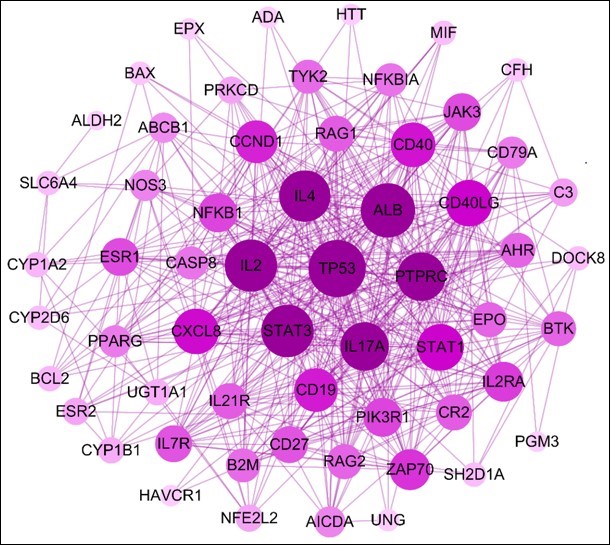Plant compound shows promise for alleviating food allergies
Researchers combined advanced computational methods with experimental studies to gain new insight, at the cell level, into how the plant compound formononetin might be used to treat food allergies. With nearly 10% of the world population affected by food allergies — which are sometimes life-threatening — new treatments are critically needed.
Formononetin is found in plants and herbs such as red clover and green beans and has been shown to have anticancer properties. It is a phytoestrogen, meaning that it has a structure similar to the hormone estrogen and can bind to the body’s estrogen receptors.

“Our findings show that formononetin is a particularly good therapeutic candidate for treating food allergies,” said Ibrahim Musa, a doctoral candidate in pathology, microbiology and immunology at New York Medical College. “Our research also revealed new mechanisms and targets that can be utilized to design future drugs for treating food allergies and other allergic disorders or to prevent severe anaphylaxis seen in allergic diseases.”
Musa will present the new research at the American Society for Biochemistry and Molecular Biology annual meeting during the Experimental Biology (EB) 2022 meeting, to be held April 2–5 in Philadelphia.
Food allergies occur when the immune system treats a food or something in a food as a threat. This causes the immune system to produce immunoglobulin E (IgE) antibodies that react to the food and can cause allergy symptoms such as hives, asthma, itching, trouble breathing or diarrhea.
In previous studies, the researchers identified formononetin as a potential therapeutic for allergies because it decreased IgE production. To find out more, the researchers turned to an approach known as systems pharmacology. This involved using data from publicly available databases to identify gene and protein targets regulated in food allergy and mast cells diseases. Mast cells also play an important role in IgE-mediated allergic diseases.
Once they identified gene and protein targets, the researchers validated them using cultured cell lines that are commonly used in allergy studies. These cell experiments showed that formononetin did influence the expression of gene and protein targets identified using systems pharmacology.
“Our study demonstrates that system pharmacology can be used to predict drug/ compound–target interaction,” said Musa. “What’s more, the mechanism of action identified for formononetin is also important for other allergic diseases such as allergic asthma and hay fever. This suggests that formononetin or other therapeutic candidates that decrease IgE production could be useful for treating these diseases.”
The researchers have developed a mouse model of peanut allergy that they plan to use to study formononetin and identify potential side effects.
Ibrahim Musa will present this research from 12:30–1:45 p.m. Tuesday, April 5, in Exhibit/Poster Hall A-B, Pennsylvania Convention Center (Poster Board Number A235) (abstract).
Enjoy reading ASBMB Today?
Become a member to receive the print edition four times a year and the digital edition monthly.
Learn moreGet the latest from ASBMB Today
Enter your email address, and we’ll send you a weekly email with recent articles, interviews and more.
Latest in Science
Science highlights or most popular articles

Mapping fentanyl’s cellular footprint
Using a new imaging method, researchers at State University of New York at Buffalo traced fentanyl’s effects inside brain immune cells, revealing how the drug alters lipid droplets, pointing to new paths for addiction diagnostics.

Designing life’s building blocks with AI
Tanja Kortemme, a professor at the University of California, San Francisco, will discuss her research using computational biology to engineer proteins at the 2026 ASBMB Annual Meeting.

Cholesterol as a novel biomarker for Fragile X syndrome
Researchers in Quebec identified lower levels of a brain cholesterol metabolite, 24-hydroxycholesterol, in patients with fragile X syndrome, a finding that could provide a simple blood-based biomarker for understanding and managing the condition.

How lipid metabolism shapes sperm development
Researchers at Hokkaido University identify the enzyme behind a key lipid in sperm development. The findings reveal how seminolipids shape sperm formation and may inform future diagnostics and treatments for male infertility.

Mass spec method captures proteins in native membranes
Yale scientists developed a mass spec protocol that keeps proteins in their native environment, detects intact protein complexes and tracks drug binding, offering a clearer view of membrane biology.

Laser-assisted cryoEM method preserves protein structure
University of Wisconsin–Madison researchers devised a method that prevents protein compaction during cryoEM prep, restoring natural structure for mass spec studies. The approach could expand high-resolution imaging to more complex protein systems.

